The Buddha Images and Conservation and Adherence to Cultural Values in Northeast
Abstract
Problem statement: This study is caused by the problem of conservation of the Buddha images to exist in the original condition and by the problem of transference and adherence to indigenous knowledge of local craftsmen. At present there have not yet been systematic and wide conservation and adherence to the Buddha images. Other causes are such as incorrect techniques of conserving the Buddha images, lack of encouraging people and the community to appreciate the Buddha images, incorrect techniques of restoring the Buddha images, lack of increment of economic and cultural values in terms of tourism, lack of correct techniques of studying styles of the Buddha images to rebuild the styles for the community to appreciate local art, lack of clear examination of the background and there have not been comparative studies to find out relationships with other localities. Purposes were to examine backgrounds of Isan Buddha images and iconology, to examine current conditions and problems of the Buddha images and to investigate models of conservation and adherence to cultural values in Iran. Study area covered Changwat Maha Sarakham, Changwat Kalasin and Changwat Roi Et where there have been long backgrounds and continuous developments of the Buddha image in all Ages. Approach: This study used qualitative methodology by collecting data from related literature and from field studies by interviews and focused group discussion from totally 66 informants. Findings were presented by means of a descriptive analysis. Results: The result of this research revealed that there were 5 models of the Buddha image art found in Isan: Sandstone Buddha images, baked-clay votive tablets, cast motar Buddha images, bronze Buddha images and wooden Buddha images. They were in the Periods of Dvaravati, Lop Buri and Lan Chang. The Buddha images were popularly built in many different styles such as concentration style, double-miracle style, nag-over-his-head style, blessing style, world-opening style, relatives-stop style, dharma consideration style and others. In addition, they popularly made 4,9,12 or 168 votive tablets on each of a large number of baked-clay plates. Significant characteristics of the Buddha images were different based on the outside influences they received. Conclusion: The Buddha images of the Dvaravati Period were influenced from India in the art styles of Kupta, Pala, Sena and Pallava to central of Thailand. Those of the Lop Buri Period were influenced by Khmer art. Those of the Lan Chang Period were influenced by Lan Chang art which had been influenced by Lan Na Savana. The bronze Buddha images were popularly made in the concentration style and the maravijaya style. The wooden Buddha images were popularly made in the styles of maravijaya, concentration, dharma consideration and others.
DOI: https://doi.org/10.3844/jssp.2010.320.323

- 3,347 Views
- 2,492 Downloads
- 0 Citations
Download
Keywords
- Buddha image characteristics
- the Buddha image art
- iconology
- dharma philosophy
